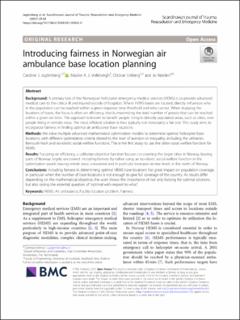| dc.contributor.author | Jagtenberg, Caroline J. | |
| dc.contributor.author | Vollebergh, Maaike A. J. | |
| dc.contributor.author | Uleberg, Oddvar | |
| dc.contributor.author | Røislien, Jo | |
| dc.date.accessioned | 2021-06-14T13:30:26Z | |
| dc.date.available | 2021-06-14T13:30:26Z | |
| dc.date.created | 2021-06-10T13:11:26Z | |
| dc.date.issued | 2021-03 | |
| dc.identifier.citation | Jagtenberg, C.J., Vollebergh, M.A.J., Uleberg, O., Røislien, J. (2021) Introducing fairness in Norwegian air ambulance base location planning. Scandinavian Journal of Trauma, Resuscitation and Emergency Medicine, 29, 50. | en_US |
| dc.identifier.issn | 1757-7241 | |
| dc.identifier.uri | https://hdl.handle.net/11250/2759363 | |
| dc.description.abstract | Background
A primary task of the Norwegian helicopter emergency medical services (HEMS) is to provide advanced medical care to the critical ill and injured outside of hospitals. Where HEMS bases are located, directly influences who in the population can be reached within a given response time threshold and who cannot. When studying the locations of bases, the focus is often on efficiency, that is, maximizing the total number of people that can be reached within a given set time. This approach is known to benefit people living in densely populated areas, such as cities, over people living in remote areas. The most efficient solution is thus typically not necessarily a fair one. This study aims to incorporate fairness in finding optimal air ambulance base locations.
Methods
We solve multiple advanced mathematical optimization models to determine optimal helicopter base locations, with different optimization criteria related to the level of aversion to inequality, including the utilitarian, Bernoulli-Nash and iso-elastic social welfare functions. This is the first study to use the latter social welfare function for HEMS.
Results
Focusing on efficiency, a utilitarian objective function focuses on covering the larger cities in Norway, leaving parts of Norway largely uncovered. Including fairness by rather using an iso-elastic social welfare function in the optimization avoids leaving whole areas uncovered and in particular increases service levels in the north of Norway.
Conclusions
Including fairness in determining optimal HEMS base locations has great impact on population coverage, in particular when the number of base locations is not enough to give full coverage of the country. As results differ depending on the mathematical objective, the work shows the importance of not only looking for optimal solutions, but also raising the essential question of ‘optimal with respect to what’. | en_US |
| dc.language.iso | eng | en_US |
| dc.publisher | BioMed Central | en_US |
| dc.rights | Navngivelse 4.0 Internasjonal | * |
| dc.rights.uri | http://creativecommons.org/licenses/by/4.0/deed.no | * |
| dc.subject | luftambulanse | en_US |
| dc.subject | helicopter emergency medical services | en_US |
| dc.title | Introducing fairness in Norwegian air ambulance base location planning | en_US |
| dc.type | Journal article | en_US |
| dc.type | Peer reviewed | en_US |
| dc.description.version | publishedVersion | en_US |
| dc.rights.holder | © The Author(s). 2021 | en_US |
| dc.subject.nsi | VDP::Medical disciplines: 700::Clinical medical disciplines: 750::Traumatology: 783 | en_US |
| dc.source.pagenumber | 10 | en_US |
| dc.source.volume | 29 | en_US |
| dc.source.journal | Scandinavian Journal of Trauma, Resuscitation and Emergency Medicine | en_US |
| dc.identifier.doi | 10.1186/s13049-021-00842-0 | |
| dc.identifier.cristin | 1915061 | |
| dc.source.articlenumber | 50 (2021) | en_US |
| cristin.ispublished | true | |
| cristin.fulltext | original | |
| cristin.qualitycode | 1 | |

